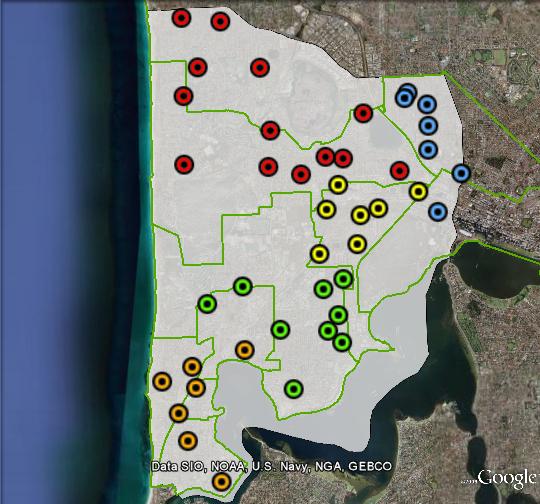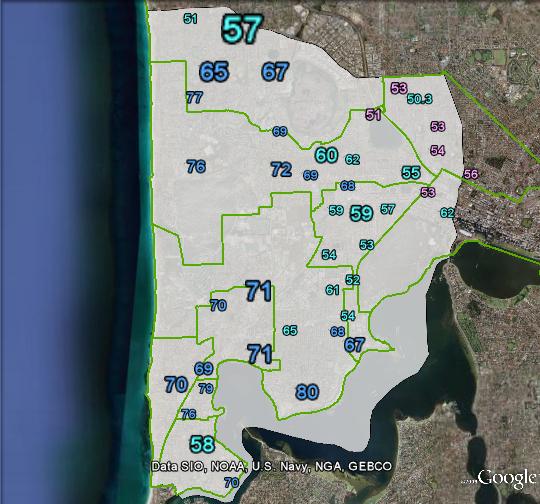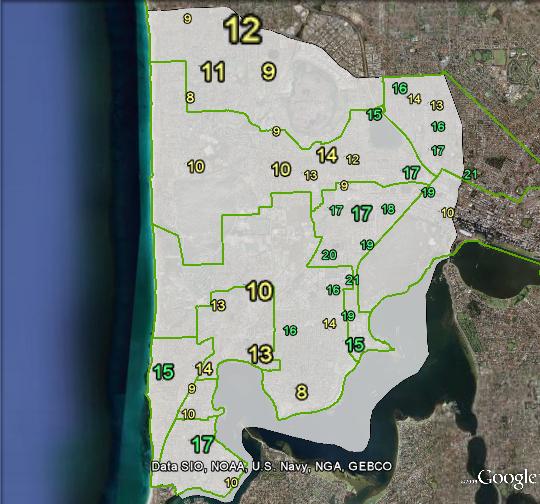LIB 13.3%
Incumbent MP
Julie Bishop, since 1998.
Geography
Western Perth. Curtin covers those suburbs between the northern shore of the Swan River and the Indian Ocean, stretching east to just outside of the Perth CBD. Curtin stretches as far north as Doubleview and Joondanna. Key suburbs include Churchlands, Leederville, Wembley, Jolimont, Subiaco, Kings Park, Nedlands, Claremont, Swanbourne, Mount Claremont, Karrakatta, Floreat, Cottesloe, Peppermint Grove and Mosman Park.
Redistribution
Some changes were made to Curtin’s northern border. It lost the northern parts of Joondanna, and gained southern parts of Scarborough. This slightly reduced the Liberal margin from 13.6% to 13.3%.
History
Curtin was created as part of the expansion of the House of Representatives at the 1949 election. It has been won by the Liberal Party at all but one election, having been won by an independent former Liberal MP in 1996.
It was first won in 1949 by Paul Hasluck. He was appointed as Minister for Territories in 1951, and served in ministerial roles for the next eighteen years, eventually becoming Minister for External Affairs. In 1969 he left Parliament when appointed as Governor-General, a role he served in until 1974.
The 1969 Curtin by-election was won by Victor Garland. He joined the ministry under Billy McMahon in 1971, serving until the 1972 election. He then served as a minister in the Fraser government from 1975 to 1976 and again from 1977 until the 1980 election. In 1981 he resigned from Parliament to serve as Australia’s High Commissioner in London.
The 1981 Curtin by-election was won by Liberal candidate Allan Rocher. Rocher had been a Senator since 1977, resigning to run for the by-election. Rocher briefly served as a shadow minister in the early 1990s, but in 1996 was defeated for preselection by Ken Court, son of former Premier Charles Court, and brother of the then-Premier Richard Court. The Court government won re-election shortly before the 1996 federal election, but was engulfed in scandals involving his brother, and Rocher, running as an independent, managed to defeat Court in Curtin, winning re-election as an independent.
Rocher lost Curtin in 1998 to Liberal candidate Julie Bishop. Bishop was appointed Minister for Ageing in the Howard government in 2003, and in 2006 was promoted to cabinet as Minister for Education.
After the defeat of the Howard government in 2007, Bishop was elected as Deputy Leader of the Liberal Party. She has served as Deputy to three successive leaders, serving as Shadow Minister for Industrial Relations under Brendan Nelson, then Shadow Treasurer, before moving to the Foreign Affairs portfolio.
Candidates
- Julie Bishop (Liberal) – Deputy Liberal leader, Member for Curtin since 1998.
- George Crisp (Greens)
- Sophie van der Merwe (Labor)
- Pat Seymour (Christian Democratic Party)
Political situation
Curtin is the safest seat in Western Australia. Bishop should have no trouble winning re-election.
2007 result
| Candidate | Party | Votes | % | Swing |
| Julie Bishop | LIB | 46,912 | 59.27 | -0.32 |
| Peter Grant | ALP | 19,419 | 24.53 | +0.78 |
| Lee Hemsley | GRN | 10,649 | 13.45 | +1.97 |
| Gail Forder | CDP | 1,004 | 1.27 | -0.41 |
| Shahar Helel | IND | 445 | 0.56 | +0.56 |
| Bev Custers | FF | 394 | 0.50 | +0.50 |
| Albert Caine | ON | 329 | 0.42 | -0.56 |
2007 two-candidate-preferred result
| Candidate | Party | Votes | % | Swing |
| Julie Bishop | LIB | 50,320 | 63.57 | -1.05 |
| Peter Grant | ALP | 28,832 | 36.43 | +1.05 |
These results do not take into consideration the effects of the redistribution.
Booth breakdown
Curtin covers seven whole council areas, and parts of three others. Subiaco and Nedlands council areas have been kept separate, with the remainder grouped into the North, South and East areas.
The ALP only won a majority in the eastern part of the seat, closest to the Perth CBD, where they won a slim majority. The Liberal Party won solid majorities in the rest of the seat, winning just under 58% in Subiaco and well over 60% in the rest of the seat, polling around 69% in the southern parts of the seat, including Nedlands council.

| Voter group | GRN % | LIB 2CP % | Total votes | % of ordinary votes |
| North | 11.36 | 63.50 | 26,631 | 39.70 |
| Nedlands | 12.78 | 69.11 | 12,938 | 19.29 |
| South | 13.61 | 68.52 | 11,679 | 17.41 |
| Subiaco | 16.88 | 57.80 | 8,562 | 12.76 |
| East | 15.25 | 49.21 | 7,273 | 10.84 |
| Other votes | 14.15 | 63.38 | 15,838 |




Curtin’s main characteristic is socio-economic status. Only the north-eastern corner of the seat does not fit either the establishment, old money profile of the riverside and southern oceanside suburbs, or the CEO and wealthy retiree demographic of the City Beach/Wembley Downs area. This will change over time, as the value of real estate in this area means the population can’t grow, and indeed every redistribution has seen Curtin grow northward and eastward to take in areas much less typically Liberal (in fact, Mount Hawthorn and Leederville in the northeast are marginal Labor with a heavy Green vote).
Especially in the riverside suburbs and in places like Subiaco and Wembley, a very strong sense of local community has emerged in each suburb with attendant local media to inform them. The Post Newspapers chain got their start here and people tend to be very well informed about what’s going on. I would suggest that this probably explains the high Green (historically Democrat) vote in parts of the seat, especially in Subiaco and Shenton Park near the city which is solidly establishment but has not for a long time been inherently conservative. This was the former stomping ground of rebel state Liberal MP Dr Tom Dadour, a local GP known for voting against the Court government on a variety of issues, most notably the closure of the Fremantle railway.
So, absolutely no change forecast for probably decades to come, but still an interesting seat nonetheless 🙂
I forgot to mention three small booths of note – the northern Wembley booth (Lake Monger Primary) which is among the most ethnically diverse booths in the area due to the high amount of mid-high value rental property in northern Wembley; and the UWA and Hospital booths which usually has the highest Green vote and does not always go to the Liberals on 2pp. I’m guessing that’s the student vote from the residential colleges (which in some cases are closer to the hospital than the uni) and nearby rental accommodation.
Would not be surprised if the strong “doctors housewives” and student votes see the Greens come close to outpoliing the ALP in Curtin in future elections, if not this one.
Such an interesting and informed site so far!
Everyone acknowledges that Curtin is a safe Liberal seat.
An electorate of City Beach millionares and fly-in fly-out miners?
The Greens should do well this time round?
But how did Julie advance so far so quick?
Well everyone in Perth knows that.
The Greens nearly beat Labor for second here (ALP 19.3%, Grn 17.4%); a similar thing happened in the corresponding state seats of Cottesloe, Nedlands and Churchlands in 2008. It looks like this part of Perth is becoming like the north shore of Sydney, where Labor are irrelevant and come third or fourth behind Greens and independents. The Greens have no chance of winning any seats in the western suburbs, though.